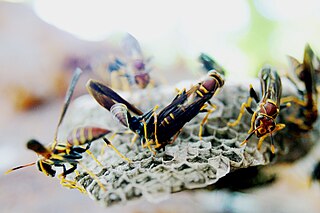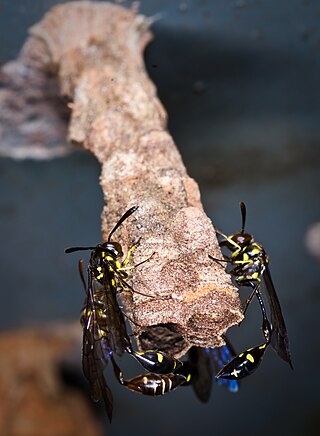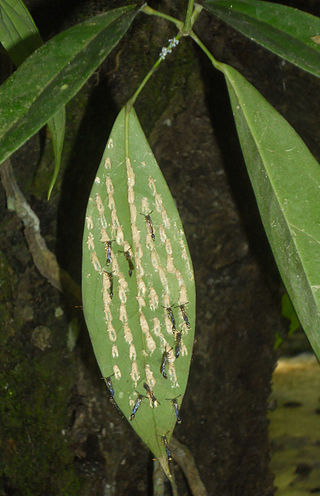
Paper wasps are a type of vespid wasps. The term is typically used to refer to members of the vespid subfamily Polistinae, though it often colloquially includes members of the subfamilies Vespinae and Stenogastrinae, which also make nests out of paper.

The European paper wasp is one of the most common and well-known species of social wasps in the genus Polistes. Its diet is more diverse than those of most Polistes species—many genera of insects versus mainly caterpillars in other Polistes—giving it superior survivability compared to other wasp species during a shortage of resources.

The Stenogastrinae are a subfamily of social wasps included in the family Vespidae. They are sometimes called hover wasps owing to the particular hovering flight of some species. Their morphology and biology present interesting peculiarities.

Ropalidia marginata is an Old World species of paper wasp. It is primitively eusocial, not showing the same bias in brood care seen in other social insects with greater asymmetry in relatedness. The species employs a variety of colony founding strategies, sometimes with single founders and sometimes in groups of variable number. The queen does not use physical dominance to control workers; there is evidence of pheromones being used to suppress other female workers from overtaking queenship.

Polistes annularis is a species of paper wasp found throughout the eastern half of the United States. This species of red paper wasp is known for its large size and its red-and-black coloration and is variably referred to as a ringed paper wasp or jack Spaniard wasp. It builds its nest under overhangs near bodies of water that minimize the amount of sunlight penetration. It clusters its nests together in large aggregations, and consumes nectar and other insects. Its principal predator is the ant, although birds are also known to prey on it. Unlike other wasps, P. annularis is relatively robust in winter conditions, and has also been observed to store honey in advance of hibernation. This species has also been used as a model species to demonstrate the ability to use microsatellite markers in maternity assignment of social insects.

Polistes fuscatus, whose common name is the dark or northern paper wasp, is widely found in eastern North America, from southern Canada through the southern United States. It often nests around human development. However, it greatly prefers areas in which wood is readily available for use as nest material, therefore they are also found near and in woodlands and savannas. P. fuscatus is a social wasp that is part of a complex society based around a single dominant foundress along with other cofoundresses and a dominance hierarchy.
Belonogaster juncea juncea is a subspecies of Belonogaster juncea and is classified as a primitively eusocial wasp, meaning that the species is social while exhibiting a morphology that is indistinguishable from that of other castes. It is also classified as a type of African Paper Wasp. Many of the studies relating specifically to B. j. juncea take place at the University of Yaoundé in Cameroon.

Polistes instabilis, or Unstable paper wasp is a type of paper wasp, is a neotropical, eusocial wasp that can be found in tropical and subtropical areas such as Central America and South America. It can be easily identified with its characteristic yellow, brown, and reddish markings, and it builds nests made from chewing plant fibers and making them into paper.
Ropalidia fasciata, a common paper wasp, is a wide-ranging species that is distributed from India to the Lesser Sunda Islands, Palawan, and Ryukyu Islands, occupying the northern edge of Ropalidia's larger distribution. These primitively eusocial wasps are unique in that they do not exhibit the strict matrifilial, single-queen social structure found in many species of social insects. Instead, colonies are founded based on associations between several females, or 'foundresses'.

Parischnogaster mellyi is a medium-sized species of a hover wasp in the family Vespidae. It is found in Southeast Asia and is widely spread in Thailand and Malaysia. Its nests feature flexible and dynamic qualities, and they are commonly seen under roofs of houses and huts in rural areas. Hovering and patrolling behaviors are the species’ main defining behavioral features, and such activities are closely linked to its mating patterns.

Belonogaster petiolata is a species of primitively eusocial wasp that dwells in southern Africa, in temperate or subhumid climate zones. This wasp species has a strong presence in South Africa and has also been seen in northern Johannesburg. Many colonies can be found in caves. The Sterkfontein Caves in South Africa, for example, contain large populations of B. petiolata.

Ropalidia revolutionalis, the stick-nest brown paper wasp, is a diurnal social wasp of the family Vespidae. They are known for the distinctive combs they make for their nests, and they have been found in Queensland, Australia in the areas of Brisbane and Townsville. They are an independent founding wasp species, and they build new nests each spring. They can be helpful because they control insect pests in gardens.

Ropalidia plebeiana is a eusocial temperate paper wasp. It is unique, as it is the only temperate wasp in the typically tropical Ropalidia genus. R. plebeiana is widely distributed in eastern Australia, and recently have been found making huge nest aggregations, with thousands of nests on trunks of trees, in south-eastern New South Wales.

Parischnogaster alternata, the black hover wasp, is a eusocial wasp in the genus Parischnogaster. It is native to South-East Asia, and builds its nests in cavities located in dark and damp locations. The nests of black hover wasps are often found in clusters, which serves as a passive defense mechanism against predators. The annual colony cycle begins with nest initiation by a single foundress though colonies typically consist of 2-3 associative females and helpers that aid in brood development, nest construction, and colony defense. Indicative of the name, female P. alternata are known to strategically hover near nests when visiting other colonies before landing. These intrusions produce responses ranging from aerial fighting to cooperative food sharing.
Parischnogaster nigricans serrei is a hover wasp subspecies in the family Vespidae, and it is predominantly found in the Java region of Indonesia. Its nest cells are of conical structure, linearly attached to a string-like substratum. The nests are typically found in places open to human interactions, such as gardens, trees, or forests around villages. There is a clear dominance hierarchy within colonies, which often affects the behavioral activities of its members. The wasp’s most common predators are Vespa tropica, also known as the great banded hornet. P. nigricans serrei defends itself by flying away or giving out alarm calls.

Parischnogaster striatula is a species of social hover wasps found in Southeast Asia. Their nests are uniquely shaped, mimic their surroundings and, like the other Stenogastrinae social wasps, lack a nest pedicel. They are also unique in their use of glandular secretion when laying eggs. P. striatula is also different than typical wasps because the queens are not the only ones who possess reproductive capabilities; other females also have developed ovaries. This wasp is also known for fiercely protecting its nest against enemies, such as ants or other hornets.

Liostenogaster vechti is a type of eusocial hover wasp within the family Vespidae. They are typically brown and yellow in color and are considered a passive aggressive species. Their stings are less painful to humans than other social wasps, and they engage in associative nest foundation. They are mostly found on the Malaysian peninsula and are known for living in large clusters of small ring-shaped nests.

Polistes dorsalis is a species of social wasps that can be found throughout various parts of North America. It is classified under the Vespidae within the genus of Polistes. Male Polistes dorsalis wasps can be distinguished from other Polistes species by their distinctly prominent median tubercle of sternum 7. Both sexes can also be recognized due to their v- shaped yellow markings on their head. They are distributed widely across North America and can be found in sheltered nests, typically closer to the ground. These wasps live in a dominance hierarchy in which the queen's role differs from that of ordinary workers. When threatened, these wasps can deliver moderately painful stings. Their venom might also be of human interest for their antimicrobial uses.

Parischnogaster jacobsoni is a species of social wasp within Parischnogaster, the largest and least known genus of Stenogastrinae. It is distinguished mainly by its tendency to construct ant guards on its nests. Natural selection has led this wasp to have a thick substance emitted from its abdominal glands that allows it to protect its nest from invasions. Parischnogaster as a genus has been relatively unstudied; P. jacobsoni is one of the few investigated species because it has sufficient durability to live near human populations and it has demonstrated unusual resilience to pollution. While P. jacobsoni is a more complex organism than other wasps in Parischnogaster, the genus overall is relatively primitive with respect to social wasps as a whole.

Liostenogaster is a genus of hover wasps from the subfamily Stenogastrinae of the family Vespidae which has a distribution centred on south-east Asia. It was named by the Dutch entomologist Jacobus van der Vecht from material collected by Japanese scientists on an expedition to Thailand, Malaysia and Cambodia which took place in 1966.
















